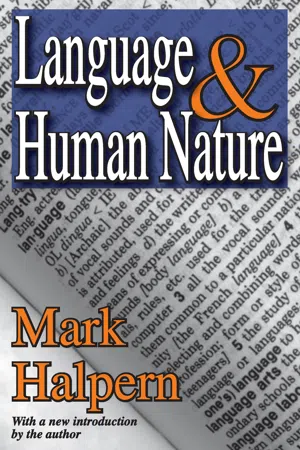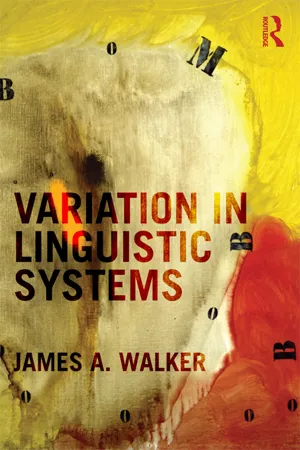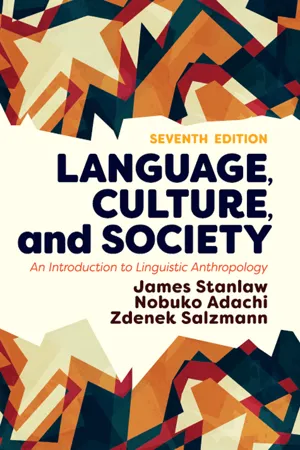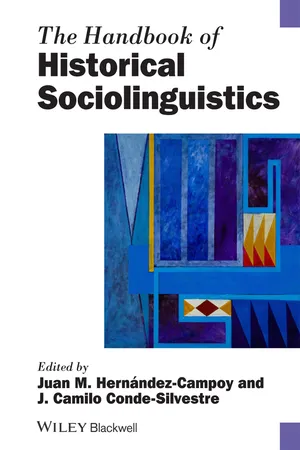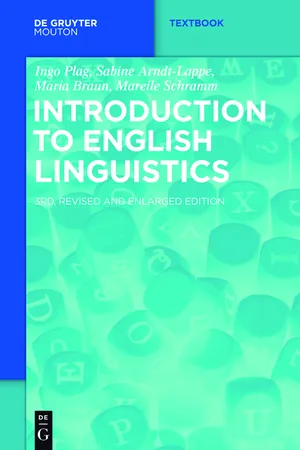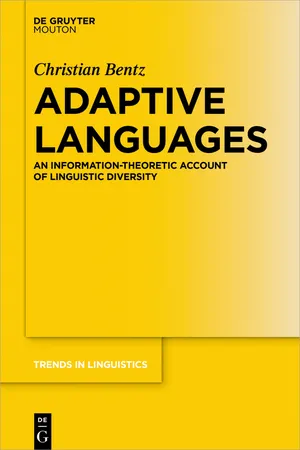Languages & Linguistics
Language Changes
Language changes refer to the natural evolution of languages over time, including shifts in vocabulary, grammar, pronunciation, and usage. These changes can be influenced by various factors such as cultural shifts, technological advancements, and contact with other languages. Linguists study language changes to understand the mechanisms behind linguistic evolution and to track the development of different language varieties.
Written by Perlego with AI-assistance
Related key terms
Related key terms
1 of 4
Related key terms
1 of 3
7 Key excerpts on "Language Changes"
- eBook - ePub
The History of English
A Student's Guide
- Ishtia Singh(Author)
- 2013(Publication Date)
- Routledge(Publisher)
(like functions as both discourse marker and quotative complementizer). Nevertheless, such work is complementary to more structure-based accounts of grammaticalization; together, they should achieve no less than increasing our understanding of such processes.The explanations of the preceding sections have necessarily portrayed language change as an ordered and neat phenomenon. This is in fact not the case: change is, for want of a better phrase, quite ‘messy’ indeed. The processes we have considered may or may not occur, and if they do, do not affect the usage of all speakers, and certainly not at the same time. This means that change contributes to synchronic variation in a language system – old and new, and new and new, variants may co-exist at any one time in a speech community. It also has a diachronic effect – as some variants become dominant and are retained and as others are lost, the ‘linguistic character’ of the language (at least, of the language preserved in the textual record) also changes, as we will see in our narrative of English from Anglo-Saxon times to the present day (Chapters 3 –6 ). But processes of change not only ‘move’ a language from one stage to another; they can also, given enough time and appropriate conditions, eventually result in the gradual emergence of a new language. Such lines of linguistic descent also constitute an integral part of a language's diachronic narrative, and it is to a discussion of research in this area that we turn in Chapter 2 .1.7 Study Questions
1. The following data illustrates a current vowel shift in American English – the Northern Cities Shift, which is taking place in the industrial inland North and is most strongly advanced in the largest cities including Syracuse, Buffalo, Cleveland, Toledo, Detroit, Chicago and Rockford: - eBook - ePub
- Mark Halpern(Author)
- 2017(Publication Date)
- Routledge(Publisher)
CHAPTER 1 The Question of Change in Language We know, of course, that it is not the English language which does something when it changes. We know that this has something to do with the people who use it. But what?– Rudi Keller2The root of the confusion: why does language change?
The educated speaker of English today, especially one “fascinated by words,” is almost certain to hold the view that language is and must always be changing, and that change of any kind is a Good Thing. There may be particular changes he is not happy about, but he is not likely to try to oppose them; he is persuaded that resistence to lexical changes is both futile and something close to politically reactionary. And he will have gotten that idea, directly or indirectly, from the professional academic students of language called linguists. There are many schools of linguists, and they can be quite sharp in criticizing each other, but they are as one in holding and propagating a view of language change of which the layman’s version is a somewhat degraded copy. (By “language change” and similar expressions I will mean, unless otherwise stated, changes in the English vocabulary: newly coined or imported words, or old words in new senses.) Linguists indiscriminately accept the idea of change, seeing it as springing from “the genius of the language” expressing itself through the speech of the common people. They see resistance to any particular change as springing from ignorance and old-fogeyism, if not elitism and racism, and as in any case futile, since change will always prevail. But even while enthusiastically embracing change in their role as linguists, they are not always so welcoming of it in their private capacities; they often refuse to adopt in their own writings changes they have defended in that of others — more on this later. The standard response that one hears when any such change is questioned is some variant of Language is a living, growing thing, and all living things change. Dont interfere with life! - eBook - ePub
- James A. Walker(Author)
- 2012(Publication Date)
- Routledge(Publisher)
i ) of Generation x (see e.g. Lightfoot 1979, 1991).If this model of language change is correct, we should expect to see change occurring suddenly, across a single generation. Yet an examination of historical data shows that linguistic changes take several generations, or even centuries, to occur. Attempts to resolve this dilemma have argued that the apparent gradualness and variation of language change represent either a set of discrete changes in subsequent generations or the co-existence of discrete, categorical linguistic systems in the same speech community. However, just as we saw in Chapter 2 , variation persists no matter how thinly we slice the data. Language change advances via variation.Figure 7.1 Scenarios of language change across generations.In the variationist approach, the recognition of the inherent variability of language allows us to incorporate variation, and therefore change, into the study of language. However, while all change requires variation, not all variation necessarily leads to change. Some variables exhibit stable variation, which may persist over long periods of time. For example, the variable (ing) in English can be traced to changes that took place between Old and Middle English (Labov 1989). How do we decide whether a particular variable is stable or a change in progress?Many studies have shown that social and linguistic factors serve to initiate and impel language change, and that such conditioning can be used as evidence for or against the existence of language change. In a seminal paper written in 1968 with the late Uriel Weinreich and Marvin Herzog, Labov proposes five problems that any empirically-based account of language change needs to solve: - eBook - ePub
Language, Culture, and Society
An Introduction to Linguistic Anthropology
- James Stanlaw, Nobuko Adachi, Zdenek Salzmann(Authors)
- 2018(Publication Date)
- Routledge(Publisher)
8 Language Through Time LEARNING OBJECTIVES • Explain the various ways languages are classified. • Name some of the features of language typology. • Describe some of the regularities of sound changes. • Describe some of the processes of vocabulary change. • Be able to do reconstructions of some protolanguage forms.The structure of a language may be analyzed and described as it exists at some point in time, either in the present or the past. The approach that considers a language as though it had been sliced through time, ignoring historical antecedents, is referred to as synchronic linguistics. But it is also possible to study the historical development of a language by giving attention to the changes that occurred in the language over a period of time. Such an analysis or approach is diachronic, or historical, linguistics. This chapter shows some of the ways a diachronic approach can benefit anthropologists.HOW LANGUAGES ARE CLASSIFIEDAnyone who knows Spanish will tell you that other languages, such as Portuguese or Italian, seem to be related to Spanish. This is due to their common origin from Latin. Traditionally, one of the most common activities in historical linguistics has been to classify languages according to these genetic relationships. It is difficult to give the exact number of languages spoken in the world at present, but the total undoubtedly approaches 6,000 (Krauss 1992:5–6), possibly 7,000. It is impossible to guess how many languages must have become extinct in prehistoric times. We do know that during the historical period for which we have written records, a great many languages have died out.Language FamiliesA language family includes all those languages that are related by virtue of having descended from a single ancestral language. The concept of the language family is somewhat conservative: it is generally employed only if the relationship and the correspondences among the languages have been firmly established by careful comparative work and a convincing number of cognates. Subdivisions of a language family are usually referred to as branches. The Indo-European - eBook - ePub
- Juan Manuel Hernández-Campoy, Juan Camilo Conde-Silvestre(Authors)
- 2012(Publication Date)
- Wiley-Blackwell(Publisher)
Directions for Historical Linguistics , University of Texas Press, Austin, pp. 95–188.Passage contains an image
21 Internally- and Externally-Motivated Language Change RAYMOND HICKEY1. IntroductionThe field of historical sociolinguistics has been well served in recent years. There are several volumes which deal with this topic, starting with the seminal study by Romaine (1982) and culminating in monographs by Nevalainen and Raumolin-Brunberg (2003) and Conde-Silvestre (2007). There have been edited volumes such as Jahr (1998), special issues of journals like Conde-Silvestre and Hernández-Campoy (2005), and individual studies carrying the label ‘historical sociolinguistics’ in their titles, such as Bergs (2005). There is a network1 of scholars engaged in historical sociolinguistics, and continuing work in the field is attested by new publications such as McColl Millar (2012).Given this range of research it would seem appropriate to consider just what changes in language fall within the orbit of historical sociolinguistics. It appears to be a consensus opinion that all types of external change should be included: by implication, internal changes would be excluded. The relationship between these two sources of change has been pursued in a number of dedicated publications, such as Gerritsen and Stein (1992), Dorian (1993), Yang (2000), Pargman (2002), Jones and Esch (2002), and Torgersen and Kerswill (2004). In overviews of historical linguistics the issue is usually examined, for example in Chapter 11 of Campbell (1998/2004), ‘Explaining linguistic change,’ there is a section entitled ‘Internal and external causes’ (Campbell 1998/2004: 316–26); in Croft (2001: 166–74) there is a section ‘Communities, societies and the internal/external distinction in language change,’ to mention two well-known overviews of historical linguistics and language change of the past decade. Sources of change are also central to the comprehensive, three-volume work by Labov (1994, 2001, 2010), especially the first two volumes. - eBook - ePub
- Ingo Plag, Sabine Arndt-Lappe, Maria Braun, Mareile Schramm(Authors)
- 2015(Publication Date)
- De Gruyter Mouton(Publisher)
7 Extensions and applications: historical linguistics, sociolinguistics and psycholinguistics
7.1 Introduction
In the preceding chapters you have encountered a host of language phenomena from various domains (phonetics, phonology, morphology, syntax, semantics, pragmatics), and you have learned how these phenomena can be investigated in order to find out more about the structure and use of language. Apart from these areas of linguistic research, scholars (and laypersons) are interested in many more questions concerning language and languages. In this chapter we will deal with three of such sets of questions. First, there are historical questions. How do languages develop and where do individual languages come from? What is the historical relationship between languages, e.g. between English and German? Why and how do languages change? Another set of questions concerns the social significance of language. Why is it that after listening to only a few words a speaker has uttered, we seem to know a lot about this speaker’s social background, for example her education, her social status, in which region she probably grew up, etc.? What exactly is it that is so telling? Third, many people are curious about how humans store and process language, and what language can reveal about our cognitive capacities in general.We will deal with each set of questions in turn, looking at important studies in these fields in an exemplary fashion. As you will notice, trying to meaningfully answer such questions necessitates a general understanding about how language ‘works’, i.e. what kinds of structural entities language consists of and how these entities interact with each other to create that highly complex system we call language. Having worked through the preceding chapters, you are now equipped with this kind of understanding. - eBook - ePub
Adaptive Languages
An Information-Theoretic Account of Linguistic Diversity
- Christian Bentz(Author)
- 2018(Publication Date)
- De Gruyter Mouton(Publisher)
𝘵 is classified. Whether this threshold has been reached is directly linked to the prevalence of respective subpopulations, their network competences, and the entirety of linguistic interactions resulting from these. As a consequence, there is a tight link between population structure and language structure in this model.Ultimately, we want to know the factors that drove or caused the language to replace one linguistic feature for another. What caused the change of nominal plural morphology from a variety of patterns towards a regular -s pattern in the case of OE and ModE? Within the usage-based CAS account, the answer has to lie in the network competences and the linguistic interactions of subpopulations, that is, in differing pressures of learning and usage. In this context, neutral change , i.e. change unrelated to particular selection pressures, has been argued to constitute the null-model – in parallel to biological evolution. Furthermore, the size of a population , the percentage of adult learners present, and the status associated with a language might be causally related to language structures changing over time. Finally, geographical and genealogical phenomena such as population drift and phylogenetic grouping are intertwined with these effects.Neutral change
The term “neutral change” denotes a process whereby a particular variant replaces other variants in a population without necessarily conferring an adaptive advantage, i.e. without being directly selected for. This process is sometimes also referred to as “random copying”. In a linguistic context, this is the case if “the probability of a language learner adopting any given linguistic variant only depends on the frequency of that variant in the learner’s environment” (Kauhanen, 2017, p. 327). If this is the case, then frequency of usage – plus some random noise – is sufficient to explain the rise and fall of linguistic features from phonemes to syntax. Since neutral change in this sense is tightly linked with frequencies of usage, it has been associated with usage-based accounts of language change (Baxter et al., 2006, 2009; Blythe and Croft, 2012). Language-like phenomena that have been argued to arise in this manner include Zipf’s law of word frequencies (Reali and Griffiths, 2010) and S-curve shapes characteristic of the frequency increase and decrease of variants in competition (Reali and Griffiths, 2010; Kauhanen, 2017; Yanovich, 2016). Moreover, Kauhanen (2017) argues based on computational simulations that neutral drift should be seen as the default mechanism rather than a last resort to explain language change.
Index pages curate the most relevant extracts from our library of academic textbooks. They’ve been created using an in-house natural language model (NLM), each adding context and meaning to key research topics.
Explore more topic indexes
Explore more topic indexes
1 of 6
Explore more topic indexes
1 of 4

